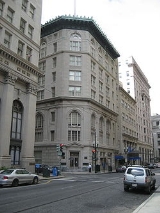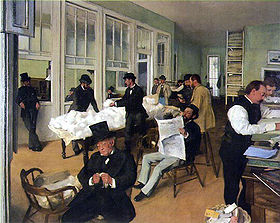
New Orleans Cotton Exchange
Encyclopedia
The New Orleans Cotton Exchange was established in New Orleans, Louisiana
, in 1871 as a centralized forum for the trade of cotton. It operated in New Orleans until closing in 1964. Occupying several buildings over its history, its final location, the New Orleans Cotton Exchange Building, is now a National Historic Landmark
.
at a time when one-third of the entire production of cotton in the United States
was sent through New Orleans. The Exchange sought to bring order to what was a highly speculative and often erratic cotton pricing system by providing a centralized trading office where people involved in the cotton business could obtain information about market conditions and prices. The Exchange also established standards for classification of cotton and facilitated payments between buyers and sellers.
The New York Cotton Exchange
opened in 1870. Concerned that trading of cotton in New York would be more advantageous to buyers than sellers, and eager to modernize their operations, New Orleans merchants agreed to form their own exchange. Consequently, the New Orleans Cotton Exchange opened for business on February 20, 1871 at the corner of Gravier and Carondelet Streets, in an area already frequented by cotton merchants.
The Exchange was notable for developing advanced techniques for gathering information about various aspects of the cotton market. Led by Col. Henry G. Hester, for many years the secretary of the Exchange, reports were compiled and then transmitted by telegraph, a novel method at the time. Col. Hester also brought the practice of futures trading to the Exchange. These advanced business methods benefited the local cotton market greatly, so much so that it "enabled New Orleans to regain its position as the primary spot market of the world and to become a leading futures market, outranked only by Liverpool and New York."
Later years saw the decline of the Exchange as fluctuating market conditions, government regulations, price supports, the decline of cotton in the South, and various other factors conspired to shrink the Southern cotton market drastically. The Exchange closed in 1964. A handful of attempts were made in later years to re-start a similar exchange, but none were successful.
However, in 1916, the building was deemed unsafe and planning began for a replacement. World War I and several other factors conspired to delay the construction of the replacement until 1921, and the original plans for an equally-lavish replacement building were scaled back.
The resulting structure was much more modest, modeled after a Renaissance palazzo. The Cotton Exchange occupied this building until its 1964 closure, selling the building in 1962 and merely renting space for the last two years of operation.
Today, the building is a hotel in the New Orleans Central Business District
. It was listed on the National Register of Historic Places
in 1977, and has been named a National Historic Landmark
.
 The renowned French
The renowned French
artist Edgar Degas
painted the picture of a cotton office seen here in 1873 while visiting his mother's Louisiana relatives.
Although certain sources label the painting as depicting the Cotton Exchange, the setting of the painting is actually the office of a cotton factor in a nearby building known as "Factors' Row."
Louisiana
Louisiana is a state located in the southern region of the United States of America. Its capital is Baton Rouge and largest city is New Orleans. Louisiana is the only state in the U.S. with political subdivisions termed parishes, which are local governments equivalent to counties...
, in 1871 as a centralized forum for the trade of cotton. It operated in New Orleans until closing in 1964. Occupying several buildings over its history, its final location, the New Orleans Cotton Exchange Building, is now a National Historic Landmark
National Historic Landmark
A National Historic Landmark is a building, site, structure, object, or district, that is officially recognized by the United States government for its historical significance...
.
History
The New Orleans Cotton Exchange was conceived and financed by a group of cotton factorsCotton factor
In the antebellum South, most cotton planters relied on cotton factors to sell their crops for them....
at a time when one-third of the entire production of cotton in the United States
United States
The United States of America is a federal constitutional republic comprising fifty states and a federal district...
was sent through New Orleans. The Exchange sought to bring order to what was a highly speculative and often erratic cotton pricing system by providing a centralized trading office where people involved in the cotton business could obtain information about market conditions and prices. The Exchange also established standards for classification of cotton and facilitated payments between buyers and sellers.
The New York Cotton Exchange
New York Cotton Exchange
The New York Cotton Exchange was a commodities exchange founded in 1870 by a group of one hundred cotton brokers and merchants at 1 Hanover Square in New York City.- History :...
opened in 1870. Concerned that trading of cotton in New York would be more advantageous to buyers than sellers, and eager to modernize their operations, New Orleans merchants agreed to form their own exchange. Consequently, the New Orleans Cotton Exchange opened for business on February 20, 1871 at the corner of Gravier and Carondelet Streets, in an area already frequented by cotton merchants.
The Exchange was notable for developing advanced techniques for gathering information about various aspects of the cotton market. Led by Col. Henry G. Hester, for many years the secretary of the Exchange, reports were compiled and then transmitted by telegraph, a novel method at the time. Col. Hester also brought the practice of futures trading to the Exchange. These advanced business methods benefited the local cotton market greatly, so much so that it "enabled New Orleans to regain its position as the primary spot market of the world and to become a leading futures market, outranked only by Liverpool and New York."
Later years saw the decline of the Exchange as fluctuating market conditions, government regulations, price supports, the decline of cotton in the South, and various other factors conspired to shrink the Southern cotton market drastically. The Exchange closed in 1964. A handful of attempts were made in later years to re-start a similar exchange, but none were successful.
The Building
The Exchange had its 1871 opening in a series of rented rooms in an existing building at Gravier and Carondelet. Although they moved several times, the Exchange would not leave this intersection until its closing in 1964. After constructing and then outgrowing a small building nearby on Gravier, the Exchange built a palatial Second Empire building in 1883 at the northern corner of Gravier and Carondelet, designed by architect S.S. Labouisse. Noted for its lavish interiors, the building soon became a landmark in New Orleans.However, in 1916, the building was deemed unsafe and planning began for a replacement. World War I and several other factors conspired to delay the construction of the replacement until 1921, and the original plans for an equally-lavish replacement building were scaled back.
The resulting structure was much more modest, modeled after a Renaissance palazzo. The Cotton Exchange occupied this building until its 1964 closure, selling the building in 1962 and merely renting space for the last two years of operation.
Today, the building is a hotel in the New Orleans Central Business District
New Orleans Central Business District
The Central Business District is a neighborhood of the city of New Orleans. A subdistrict of the French Quarter/CBD Area, its boundaries as defined by the City Planning Commission are: Iberville, Decatur and Canal Streets to the north, the Mississippi River to the east, the New Orleans Morial...
. It was listed on the National Register of Historic Places
National Register of Historic Places
The National Register of Historic Places is the United States government's official list of districts, sites, buildings, structures, and objects deemed worthy of preservation...
in 1977, and has been named a National Historic Landmark
National Historic Landmark
A National Historic Landmark is a building, site, structure, object, or district, that is officially recognized by the United States government for its historical significance...
.
Degas Painting

France
The French Republic , The French Republic , The French Republic , (commonly known as France , is a unitary semi-presidential republic in Western Europe with several overseas territories and islands located on other continents and in the Indian, Pacific, and Atlantic oceans. Metropolitan France...
artist Edgar Degas
Edgar Degas
Edgar Degas[p] , born Hilaire-Germain-Edgar De Gas, was a French artist famous for his work in painting, sculpture, printmaking and drawing. He is regarded as one of the founders of Impressionism although he rejected the term, and preferred to be called a realist...
painted the picture of a cotton office seen here in 1873 while visiting his mother's Louisiana relatives.
Although certain sources label the painting as depicting the Cotton Exchange, the setting of the painting is actually the office of a cotton factor in a nearby building known as "Factors' Row."
See also
- New York Cotton ExchangeNew York Cotton ExchangeThe New York Cotton Exchange was a commodities exchange founded in 1870 by a group of one hundred cotton brokers and merchants at 1 Hanover Square in New York City.- History :...
, the first cotton exchange in the United States - Mobile Cotton ExchangeMobile Cotton ExchangeThe Mobile Cotton Exchange was a commodities exchange that operated from 1871 until 1942 in the Alabama port city of Mobile to enable key local cotton factors and merchants to maintain control over cotton sales, warehousing, and shipping from Mobile Bay. It was the third cotton exchange founded in...
, the third cotton exchange in the United States, founded after New Orleans - Cotton factorCotton factorIn the antebellum South, most cotton planters relied on cotton factors to sell their crops for them....

